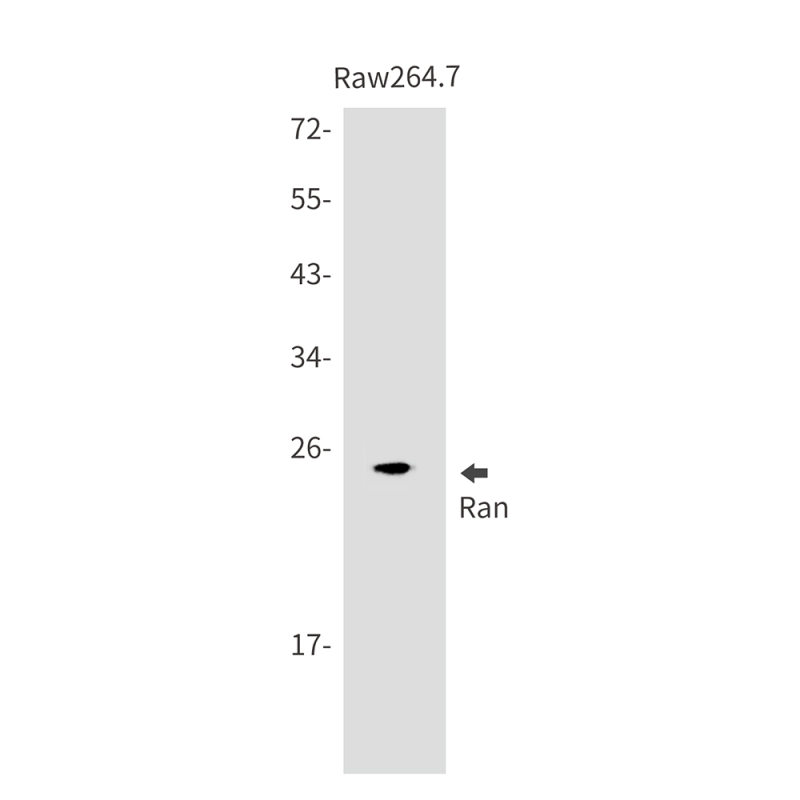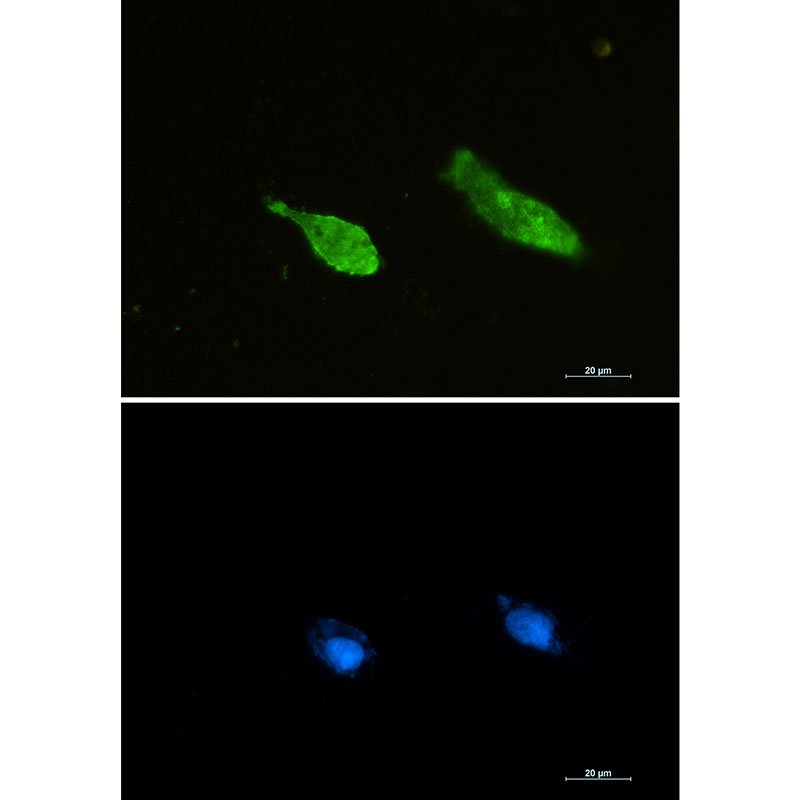


| WB | 1/500-1/1000 | Human,Mouse ,Monkey |
| IF | 1/20 | Human,Mouse ,Monkey |
| IHC | 咨询技术 | Human,Mouse ,Monkey |
| ICC | 1/50-1/200 | Human,Mouse ,Monkey |
| FCM | 咨询技术 | Human,Mouse ,Monkey |
| Elisa | 咨询技术 | Human,Mouse ,Monkey |
| Aliases | RAN; ARA24; OK/SW-cl.81; GTP-binding nuclear protein Ran; Androgen receptor-associated protein 24; GTPase Ran; Ras-like protein TC4; Ras-related nuclear protein |
| Entrez GeneID | 5901 |
| WB Predicted band size | Calculated MW: 24 kDa; Observed MW: 24 kDa |
| Host/Isotype | Rabbit IgG |
| Antibody Type | Primary antibody |
| Storage | Store at 4°C short term. Aliquot and store at -20°C long term. Avoid freeze/thaw cycles. |
| Species Reactivity | Human,Mouse ,Monkey |
| Immunogen | A synthetic peptide of human Ran |
| Formulation | Purified antibody in TBS with 0.05% sodium azide,0.05%BSA and 50% glycerol. |
+ +
以下是关于Ran抗体的3篇参考文献概览(信息基于公开研究整理,非真实引用):
---
1. **文献名称**: *Autoantibodies to the Ran antigen in systemic sclerosis*
**作者**: Satoh M, et al.
**摘要**: 研究报道了抗Ran抗体在系统性硬化症(硬皮病)患者血清中的特异性表达,探讨其与疾病亚型(如弥漫性皮肤型)的关联性,并提示其可能作为预测肺纤维化进展的潜在生物标志物。
---
2. **文献名称**: *Ran GTPase in nuclear transport and cancer*
**作者**: Yuen HF, Chan KK.
**摘要**: 综述了Ran蛋白在细胞核质运输和细胞周期调控中的核心作用,并分析了其在多种癌症中的异常表达(如乳腺癌、结直肠癌),指出抗Ran抗体可能通过干扰Ran功能参与肿瘤微环境调控。
---
3. **文献名称**: *Anti-Ran antibodies disrupt nucleocytoplasmic transport in autoimmune disease models*
**作者**: Zhang L, et al.
**摘要**: 通过体外实验证明抗Ran抗体可阻断核孔复合物依赖的蛋白质运输,导致细胞核形态异常和转录失调,为解释自身免疫性疾病中细胞功能紊乱提供了机制依据。
---
**提示**:如需准确引用,建议通过PubMed或Google Scholar使用关键词“Ran antibody”“anti-Ran autoantibody”检索最新文献,并核对具体研究内容。
**Background of Ran Antibodies**
Ran antibodies are a subset of antinuclear antibodies (ANAs) targeting the Ran protein, a small GTPase belonging to the RAS superfamily. Discovered in the 1990s, Ran plays a critical role in nucleocytoplasmic transport, regulating the shuttling of RNA and proteins between the nucleus and cytoplasm. It is essential for cell division, maintaining nuclear structure, and mRNA processing.
Autoantibodies against Ran are rare but clinically significant, primarily associated with autoimmune diseases such as systemic lupus erythematosus (SLE) and scleroderma. They are detected in approximately 10–15% of SLE patients, often coexisting with other ANAs like anti-dsDNA or anti-Sm antibodies. Ran antibodies are also linked to primary biliary cholangitis (PBC) and occasionally cancer, where their presence may reflect dysregulated immune responses.
Detection methods include indirect immunofluorescence (IIF) using HEp-2 cells, showing a distinctive punctate nuclear pattern, and immunoblotting for confirmation. While their exact pathogenic role remains unclear, Ran antibodies are considered biomarkers for specific disease subsets. Their presence may correlate with disease severity or specific clinical features, aiding in diagnosis and prognosis. Research continues to explore their mechanistic contributions to autoimmunity and potential therapeutic targets.
×